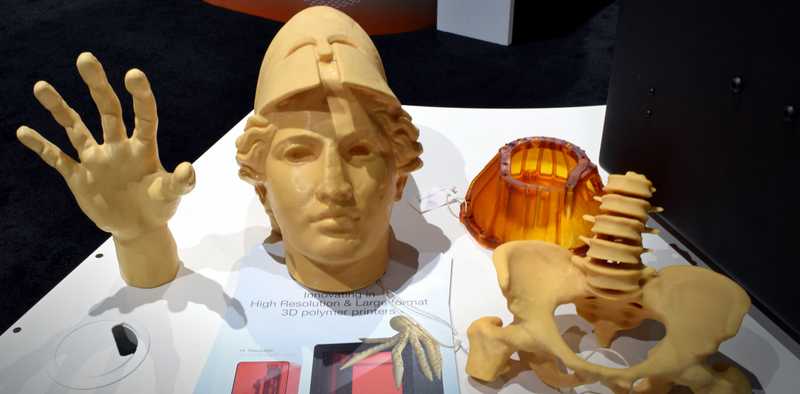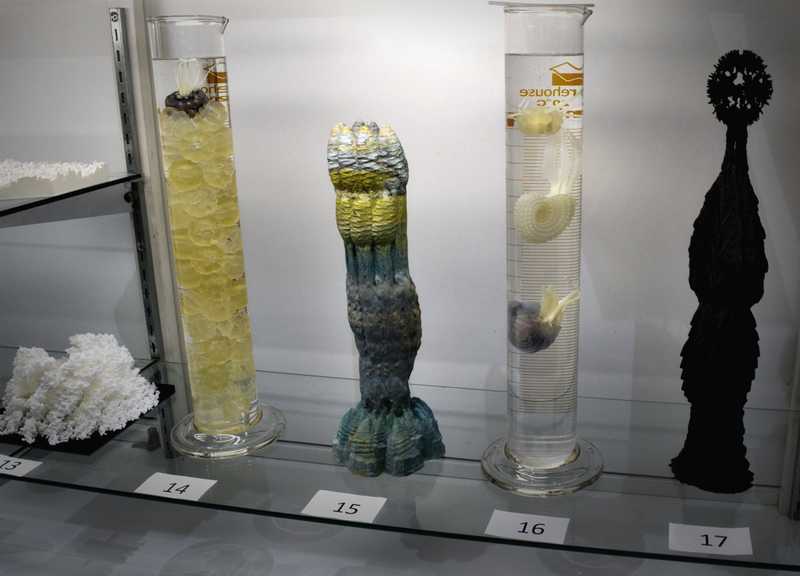The Inside 3D Printing Show
December 13–15, 2016
This is your brain on 3D printing.
Frontier Tech Forum
San Diego, California
December 13–15, 2016
Since being taken over by Rising Media from founders Meckler Media, this show has morphed from a focus entirely on 3D printing to embrace virtual and augmented reality, robotics, and other technical fields, but 3D printing-related booths still predominated. There were representatives from some—but by no means all—of the major players in the field, but the most interesting were the new machines from small companies, and some of the peripheral products being introduced, such as new materials and software products that expand the range of possibilities for those involved in this sort of thing.
I was especially impressed by the proliferation of relatively low-cost resin-based printers, which, since Formlabs introduced the Form1 a few years back, have offered better resolution and detail than the hot-plastic extrusion machines which have dominated the consumer market. Formlabs was there with their newest offering, the Form2, which features a wiper mechanism to refresh the silicone rubber tank liner and combat sticking, but two other machines based on LED and LCD light (like the screens of an iPad) offered quicker build times and much longer tank life, due to the replacement of the fragile clear rubber with a more durable teflon sheet. Two new entries were particularly impressive: the Slash printer from Uniz and the Liquid Crystal line of printers from Photocentric 3D. The Slash, which retails for about $2000, boasts a build volume of 192 × 122 × 200mm, an active cooling system, which is supposed to help it build more quickly, and three different resins, described as “ABS-like”, “silicone-like”, and “wax-like”. Based on an array of blue LEDs, masked by a high-resolution LCD screen, with a printing speed of 1000cc per hour (or 200mm/hour for hollow and thin-walled structures) it claims to be the “World’s Fastest Desktop Printer.”

Photocentric3D has three models to choose from, which use “daylight” (white light) rather than blue: the LC 10, with a build volume of 200 × 100 × 200mm and a minimum z-axis layer height of 50 microns (.002″) for $1083 suggested retail price; the LC Hi Res, with a slightly larger build volume of 200 × 150 × 200mm and a minimum layer height of 25 microns, priced at $2195 suggested retail price, and the much larger LC Pro, with a build volume of 450 × 280 × 300mm, a minimum layer height of 25 microns and a suggested retail price of $5599. This company started out as a manufacturer of chemicals, so they also have proprietary “firm”, “hard”, “flexible”, and lost-wax “castable” resins available for their machines. These resins are all water-washable, which seems like a significant improvement over having to use solvents like isopropanol to rinse out the tanks and clean the parts of excess resin.
There were also some new fused-filament printers worthy of note at this show. I liked the approach taken by the Workbench from 3D Platform, which mounted a gantry that resembled a CNC router on an actual workbench with drawers. It seemed more like a router in its construction as well, with anti-backlash ball screws throughout instead of the less precise rubber belt drives that predominate in consumer-grade machines. This printer’s build area is quite large: 1 meter square in X and Y and half a meter high, making furniture-scale projects possible, as well as being able to make a lot of small parts at once. It has a heated platform (they say an enclosure is in the works) and offers layer heights down to 70 microns (.0027″). It supports 3mm filament for faster builds, and has dual .6mm nozzles standard, with the option of other sizes from .4mm to 1.2mm. It sells for about $30,000 in its standard configuration, which takes it well out of the consumer range, but puts it in the lower price bracket for industrial printers.
Airwolf was there with the new Axiom20, with a build volume of 12.5″ × 12″ × 20″, an enclosed, heated chamber, dual printheads, and the ability to print in a wide range of filamented materials. This printer retails for about $10,000. The MarkForged printers were also there, represented by one of their resellers. These boast the strongest parts being built with extruded plastic, since they use filament that not only has carbon fibers dispersed in it, but they also have a continuous thread of carbon fiber in the middle of it, which imparts considerable tensile strength in the X-Y direction (although strength in the Z direction is much lower). And Arfona was showing off their R.Pod desktop printer, specialized for dental use. In the dual-extruder configuration ($2499) it is capable of printing parts with soluble support, using PVA which dissolves in water, or HIPS, which dissolves in limonene.
For those on a restricted budget, there were also a couple of small plastic-extrusion machines that were producing parts with barely-visible lamination marks. Asian manufacturers are starting to dominate the low end of the market, replacing some of the home-made looking machines of the early days with sleek little boxes that seem to do a great job on small parts.
Of course, there was more at this show than machines. Some of the most interesting booths were devoted to promoting applications or extensions of the technology. There were people showing off progress in things like bio-medical printing, an application for tracking fruits and vegetables as they are hand-picked in the fields, and processes that take advantage of 3D printing to do things that are difficult or impossible without it. A company called Collider, for instance, showed how to make parts in materials that are impossible to print and difficult to pull out of molds, using a process that involves printing a mold in a soluble material, pouring it full of urethane plastic, and then dissolving the mold. They plan to offer this as a service, for what seemed like a quite reasonable price. Hungary-based Leonar3do, known for its innovative stereoscopic 3D modeling system, was showing off a modeling application for the HDC Vive VR platform; this allows people to interact with their models within a virtual space, viewing it in 3D stereo vision and manipulating and changing it with simple but powerful tools, but apparently they don’t plan to offer this product to consumers; it was more to show off the possibilities of VR and their capabilities to the commercial customers they’re now focusing on.

I came down there to participate in something called “The Nature Game.” Billed as a sort of Turing test for 3D printed objects, the idea was to see if people would be able to tell the difference between manufactured objects and the unaltered products of Nature. I volunteered a couple of my sculptures for this, not because I hoped to fool anyone (they look like sculptures) but in hopes of expanding the dialogue about what exactly constitutes a natural object. Turlif Vilbrandt, who came up with this idea, is also the developer of a new file format and geometric API, called Symvol which enables designers to create complex structures without having to deal with the huge file sizes this would require if the standard STL format were used. They’ve so far released a version that plugs into Rhino and a stand-alone version called MeshUp; you can get it at uformia.
Andrew Werby